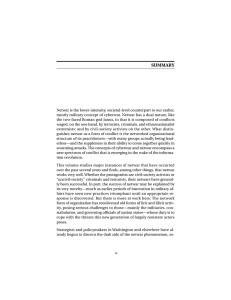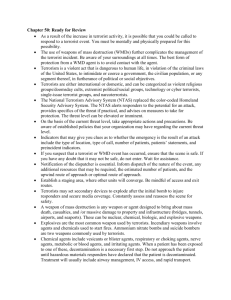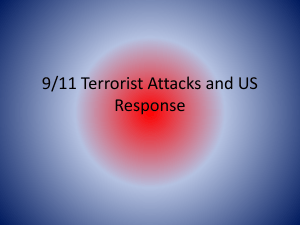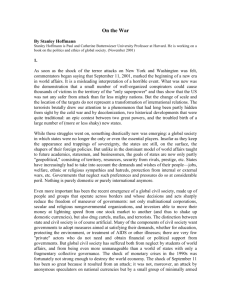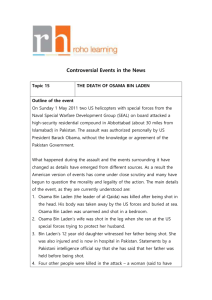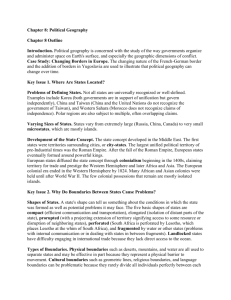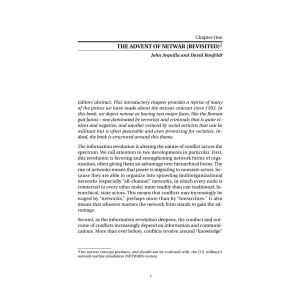Information-Age Terrorism - Naval Postgraduate School
advertisement
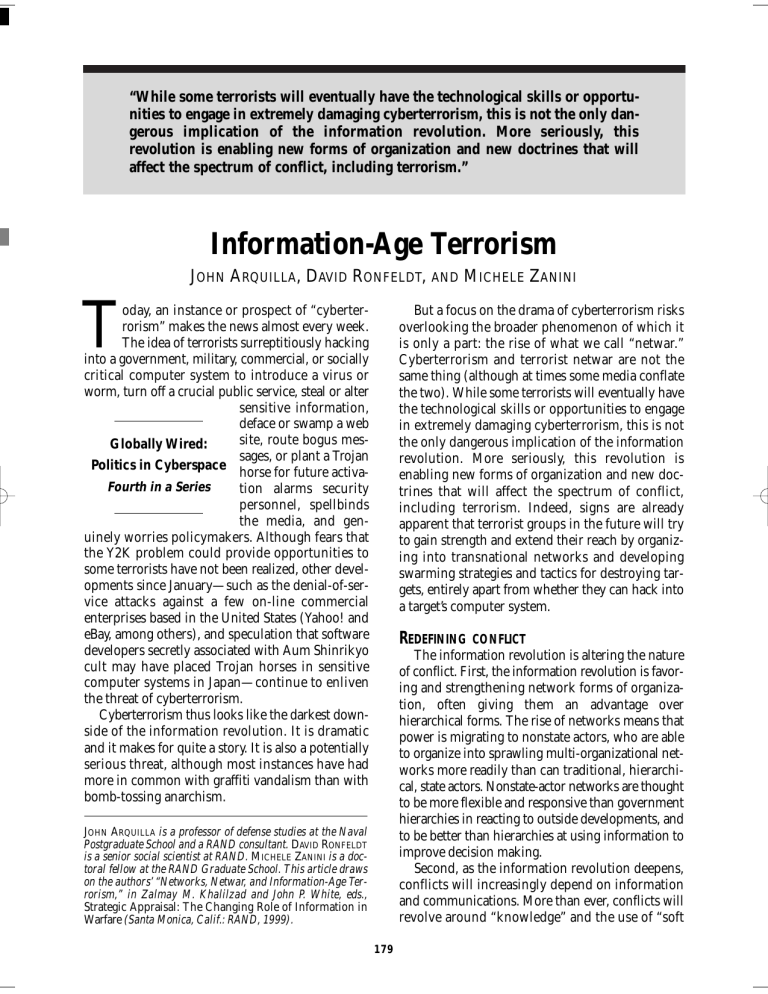
“While some terrorists will eventually have the technological skills or opportunities to engage in extremely damaging cyberterrorism, this is not the only dangerous implication of the information revolution. More seriously, this revolution is enabling new forms of organization and new doctrines that will affect the spectrum of conflict, including terrorism.” Information-Age Terrorism JOHN ARQUILLA, DAVID RONFELDT, AND MICHELE ZANINI T But a focus on the drama of cyberterrorism risks overlooking the broader phenomenon of which it is only a part: the rise of what we call “netwar.” Cyberterrorism and terrorist netwar are not the same thing (although at times some media conflate the two). While some terrorists will eventually have the technological skills or opportunities to engage in extremely damaging cyberterrorism, this is not the only dangerous implication of the information revolution. More seriously, this revolution is enabling new forms of organization and new doctrines that will affect the spectrum of conflict, including terrorism. Indeed, signs are already apparent that terrorist groups in the future will try to gain strength and extend their reach by organizing into transnational networks and developing swarming strategies and tactics for destroying targets, entirely apart from whether they can hack into a target’s computer system. oday, an instance or prospect of “cyberterrorism” makes the news almost every week. The idea of terrorists surreptitiously hacking into a government, military, commercial, or socially critical computer system to introduce a virus or worm, turn off a crucial public service, steal or alter sensitive information, deface or swamp a web site, route bogus mesGlobally Wired: sages, or plant a Trojan Politics in Cyberspace horse for future activaFourth in a Series tion alarms security personnel, spellbinds the media, and genuinely worries policymakers. Although fears that the Y2K problem could provide opportunities to some terrorists have not been realized, other developments since January—such as the denial-of-service attacks against a few on-line commercial enterprises based in the United States (Yahoo! and eBay, among others), and speculation that software developers secretly associated with Aum Shinrikyo cult may have placed Trojan horses in sensitive computer systems in Japan—continue to enliven the threat of cyberterrorism. Cyberterrorism thus looks like the darkest downside of the information revolution. It is dramatic and it makes for quite a story. It is also a potentially serious threat, although most instances have had more in common with graffiti vandalism than with bomb-tossing anarchism. REDEFINING CONFLICT The information revolution is altering the nature of conflict. First, the information revolution is favoring and strengthening network forms of organization, often giving them an advantage over hierarchical forms. The rise of networks means that power is migrating to nonstate actors, who are able to organize into sprawling multi-organizational networks more readily than can traditional, hierarchical, state actors. Nonstate-actor networks are thought to be more flexible and responsive than government hierarchies in reacting to outside developments, and to be better than hierarchies at using information to improve decision making. Second, as the information revolution deepens, conflicts will increasingly depend on information and communications. More than ever, conflicts will revolve around “knowledge” and the use of “soft JOHN ARQUILLA is a professor of defense studies at the Naval Postgraduate School and a RAND consultant. DAVID RONFELDT is a senior social scientist at RAND. MICHELE ZANINI is a doctoral fellow at the RAND Graduate School. This article draws on the authors’ “Networks, Netwar, and Information-Age Terrorism,” in Zalmay M. Khalilzad and John P. White, eds., Strategic Appraisal: The Changing Role of Information in Warfare (Santa Monica, Calif.: RAND, 1999). 179 180 • CURRENT HISTORY • April 2000 nihilistic leagues of computer-hacking “cyboteurs,” power.” Adversaries will emphasize “information may also partake of netwar. operations” and “perception management”—that is, Many—if not most—netwar actors will be nonmedia-oriented measures that aim to attract rather state. Some may be agents of a state, but others may than coerce, and that affect how secure a society, a try to turn states into their agents. Moreover, a netmilitary, or other actor feels about its knowledge of war actor may be both subnational and transnaitself and its adversaries. Psychological disruption tional in scope. Odd hybrids and symbioses are may become as important a goal as physical likely. Furthermore, some actors (for example, viodestruction. Thus, major transformations are lent terrorist and criminal organizations) may inevitable in the nature of adversaries, in the type threaten United States and other nations’ interests, of threats they may pose, and in how conflicts can but other netwar actors (for example, peaceful be waged. Information-age threats are likely to be social activists) may not. Some may aim at destrucmore diffused, dispersed, multidimensional, and tion, others at disruption. ambiguous than traditional threats. The full spectrum of netwar proponents may In light of these changes, we see netwar emerging thus seem broad at first. But an underlying pattern as a mode of conflict and crime at societal levels, cuts across all variations: the use of network forms involving measures short of traditional war in which of organization, doctrine, strategy, and technology the protagonists use network forms of organization attuned to the information age. and related doctrines, strategies, and technologies attuned to the information age. These protagonists are likely to consist of dispersed small groups that comNETWAR CONFIGURATIONS municate, coordinate, and conduct their campaigns The idea of an organizational structure qualitain an internetted manner, without a precise, stable, tively different from traditional hierarchical designs and bureaucratized attracted the attention central command. of management theoEven in information-age conflicts, real-world events The term “netwar” rists as early as the are generally more important than what happens is meant to call atten1960s. Today, in the tion to the prospect business world, virin the virtual world of cyberspace. that network-based tual or networked conflict and crime organizations are bewill become major phenomena in the decades ing heralded as effective alternatives to bureaucracies ahead. Various actors across the spectrum of conflict because of their inherent flexibility, adaptiveness, and and crime are already evolving in this direction. To ability to capitalize on the talents of all their members. give a few examples, netwar is about the Middle What has long been emerging in the business East’s Hamas more than the Palestine Liberation world is now becoming apparent in the organizaOrganization (PLO), Mexico’s Zapatistas more than tional structures of netwar actors. In an archetypal netwar, the protagonists are likely to amount to a Cuba’s Fidelistas, and the American Christian Patriot set of diverse, dispersed “nodes” that share a set of movement more than the Ku Klux Klan. ideas and interests and that are arrayed to act in a This spectrum includes familiar adversaries who fully internetted “all-channel” manner. are modifying their structures and strategies to take Networks come in three basic configurations: advantage of networked designs, such as transna1) The chain network, as in a smuggling chain tional terrorist groups, black-market proliferators where people, goods, or information move along of weapons of mass destruction, transnational crime a line of separated contacts, and where end-to-end syndicates, fundamentalist and ethnonationalist communication must travel through the intermemovements, intellectual property and high-sea diate nodes; 2) the star, hub, or wheel network, as pirates, and smugglers of migrants or black-market in a franchise or a cartel structure where a set of goods. Some urban gangs, back-country militias, actors is tied to a central node or actor, and must and militant single-issue groups in the United States go through that node to communicate and coorare also developing netwar-like attributes. In addidinate; and 3) the all-channel network, as in a coltion, a new generation of radicals and activists are laborative network of militant small groups where just beginning to create information-age ideologies, every group is connected to the other. in which identities and loyalties may shift from the We expect to observe substantial differences nation-state to the transnational level of global civil (and many hierarchy-network hybrids) in the spesociety. New kinds of actors, such as anarchistic and Information-Age Terrorism • 181 cific design choices of netwar organizations. Often the organizational structure will incorporate various elements of the three different network configurations. For example, a netwar actor may have an all-channel council at its core, but use stars and chains for tactical operations. Actual network designs depend on contingent factors, such as personalities, organizational history, operational requirements, and other influences such as state sponsorship and ideology.1 The common feature of netwar design variants is their lack of emphasis on formal, stable, and vertical command and control. Networks largely operate by consensus, which is created through dialogue and mutual trust as opposed to bureaucratic fiat. In turn, mutual trust is fostered by a strong strategic sense of shared goals and missions, along with the belief that these goals can be attained through tactical autonomy. Of the three network types, the all-channel has been the most difficult to organize and sustain historically, partly because it requires dense horizontal communication and coordination. But it has the most potential for collaborative undertakings, and is the type that seems to be gaining strength from the information revolution. Pictorially, an all-channel netwar actor resembles a geodesic “buckyball” (named for geodesic dome inventor Buckminster Fuller); it does not resemble a pyramid. Ideally, there is no single, central leadership, command, or headquarters—no precise heart or head that can be targeted. The network as a whole (but not necessarily each node) has little to no hierarchy, and it may have multiple leaders. Decision making and operations are decentralized, allowing for local initiative and autonomy. Thus the design may sometimes appear acephalous (headless), and at other times polycephalous (hydra-headed). Since bureaucratic command and control is inherently impractical in an all-channel network, the capacity of this design for effective long-term performance may depend on the presence of shared principles, interests, and goals—at best, an overarching doctrine or ideology—that spans all nodes and to 1Moreover, terrorist network nodes can be composed of a diverse set of actors—an individual, a group, an institution, or even a state sponsor. The nodes in a network need not be identical in size, influence, or function. 2 The quotation is from a doctrinal statement by Louis Beam about “leaderless resistance,” which has strongly influenced right-wing white-power groups in the United States. See Louis Beam, The Seditionist, issue 12, February 1992. which the members wholeheartedly subscribe. Such a set of principles, shaped through mutual consultation and consensus-building, can enable them to be “all of one mind,” although they are dispersed and devoted to different tasks. It can provide a central ideational, strategic, and operational coherence that allows for tactical decentralization. It can set boundaries and provide guidelines for decisions and actions so that the members need not resort to a hierarchy— “they know what they have to do.”2 The capacity for netwar is afforded by the latest information and communications technologies—cellular telephones, fax machines, e-mail, World Wide Web sites, and computer conferencing. But caveats are in order. First, the new technologies, however enabling for organizational networking, may not be the only crucial technologies for a netwar actor. Traditional means of communications, such as human couriers, and mixes of old and new systems, may suffice. Second, netwar is not simply a function of the Internet; it does not take place only in cyberspace. Netwar is not Internet war. Some key battles may occur there, but a war’s overall conduct and outcome will normally depend mostly on what happens in the real world. Even in information-age conflicts, realworld events are generally more important than what happens in the virtual world of cyberspace. Third, our concept of networks does not imply that all nodes must be in constant communication, which may not make sense for a secretive, conspiratorial actor. But when communication is needed, the network’s members must be able promptly to disseminate information as broadly as desired within the network and to outside audiences. Last, having access to the latest information technology in and of itself does not make a network—such design is made possible by the organization’s doctrine, structure, and strategy. THE STRATEGIC IMPLICATIONS A network form of organization gives distinct advantages, both offensive and defensive, to its operatives. On the offense, networks are known for being adaptable, flexible, and versatile. This may be particularly the case where a set of actors can engage in swarming. Little analytic attention has been given to swarming, yet it may be a key mode of conflict in the information age. The cutting edge for this possibility is found among netwar protagonists. Swarming occurs when the dispersed nodes of a network of forces converge on a target from multiple directions. The overall aim is the sustainable pulsing of force or fire. Once in motion, 182 • CURRENT HISTORY • April 2000 swarm networks must be able to coalesce rapidly and stealthily on a target, then dissever and redisperse, immediately ready to recombine for a new pulse. In other words, information-age attacks may come in “swarms” rather than the more traditional “waves.” In terms of defensive potential, well-constructed networks tend to be redundant and diverse, making them robust and resilient in the face of adversity. Where they have a capacity for interoperability and shun centralized command and control, network designs can be difficult to crack and defeat as a whole. In particular, they may defy counterleadership targeting—attackers can find and confront only portions of the network. Moreover, the deniability built into a network may allow it to simply absorb a number of attacks on distributed nodes, leading the attacker to believe the network has been harmed when, in fact, it remains viable, and is seeking new opportunities for tactical surprise. The difficulties of dealing with netwar actors deepen when the lines between offense and defense are blurred, or blended. When blurring is the case, it may be difficult to distinguish between attacking and defending actions, especially when an actor goes on the offense in the name of self-defense. The blending of offense and defense will often mix the strategic and tactical levels of operations. For instance, guerrillas on the defensive strategically may go on the offense tactically; the war of the mujahideen in Afghanistan provides a modern example. The blurring of offense and defense reflects another feature of netwar: it tends to defy and cut across standard boundaries, jurisdictions, and distinctions between state and society, public and private, war and peace, war and crime, civilian and military, police and military, and legal and illegal. Thus the spread of netwar increases the challenges facing the modern nation-state. Nation-state ideals of sovereignty and authority are traditionally linked to a bureaucratic rationality in which issues and problems can be neatly divided, and specific offices can be assigned certain tasks. In netwar, matters are rarely so clear. A protagonist is likely to operate in the cracks and gray areas of society, striking where lines of authority crisscross and the operational paradigms of politicians, officials, soldiers, police officers, and related actors grow fuzzy and clash. Against this background, we are led to a set of three policy-oriented propositions about the information revolution and its implications for netwar and counternetwar. Hierarchies have a difficult time fighting networks Some of the best examples of the difficulties faced by hierarchies in fighting networks are found in the failings of governments to defeat transnational criminal cartels engaged in drug smuggling, as in Colombia. The Zapatista movement in Mexico, with its legions of supporters and sympathizers among local and transnational nongovernmental organizations, shows that social netwar can put a democratizing autocracy on the defensive and pressure it to continue adopting reforms. It takes networks to fight networks Governments that would defend against netwar may need to adopt organizational designs and strategies like those of their adversaries. This does not mean mirroring the opponent, but rather learning to draw on the same design principles of network forms. These principles depend to some extent upon technological innovation, but mainly on a willingness to innovate organizationally and doctrinally, and by building new mechanisms for interagency and multijurisdictional cooperation. Fighting networks also involves the ability not only to neutralize critical nodes when these exist and are identifiable (for example, key physical targets or a group of operatives shortly before a strike), but also to disrupt the information flows that enable dispersed units to coordinate their actions. The first to master the network form will gain major advantages In these early decades of the information age, adversaries who have adopted networking are enjoying an increase in power relative to state agencies. The strategic and structural design innovations brought by networks will give these organizations an edge over slower state actors, whose strategies and tactics are shaped by a traditional, hierarchical logic. Counternetwar may thus require effective interagency approaches, which by their nature involve networked structures. The challenge will be to blend hierarchies and networks skillfully, while retaining enough core authority to encourage and enforce adherence to networked processes. By creating effective hybrids, governments may better confront the new threats and challenges now emerging, whether generated by terrorists, militias, criminals, or other actors. MIDDLE EASTERN TERRORISM AND NETWAR Terrorism seems to be evolving in the direction of violent netwar. Indeed, the netwar concept is con- Information-Age Terrorism • 183 Gama’a al-Islamiya) is the 1997 attack at Luxor, in sistent with patterns and trends in the Middle East, which 58 tourists and 4 Egyptians were killed. where the newer and more active terrorist groups Another string of terrorist attacks (and foiled appear to be adopting decentralized, flexible netattempts) has focused attention on the loosely work structures. The rise of networked arrangeorganized group of “Arab Afghans”—radical ments in terrorist organizations is part of a wider Islamic fighters from several North African and move away from formally organized, state-sponsored Middle Eastern countries who forged ties while groups to privately financed, loose networks of indiresisting the Soviet occupation of Afghanistan. One viduals and subgroups that may have strategic guidof the leaders and founders of the Arab Afghan ance but enjoy tactical independence. Related to movement is Osama bin Laden, a Saudi entreprethese shifts is the fact that terrorist groups are takneur based in Afghanistan. Bin Laden allegedly ing advantage of information technology to coordisent operatives to Yemen to bomb a hotel used by nate the activities of dispersed members. American soldiers on their way to Somalia in 1992, Terrorist organizations in the Middle East have plotted to assassinate President Bill Clinton in the diverse origins, ideologies, and structures, but can Philippines in 1994 and Egyptian President Hosni be categorized roughly into traditional and new-genMubarak in 1995, and played a role in the Riyadh eration groups. Traditional groups date to the late and Khobar blasts in Saudi Arabia that resulted in 1960s and early 1970s, and the majority were (and the deaths of 24 Americans in 1995 and 1996. some still are) formally or informally linked to the United States officials have pointed to bin Laden as PLO. Typically, they are also relatively bureaucratic the mastermind behind the American embassy and maintain a nationalist or Marxist agenda. In conbombings in Kenya trast, most new-generaand Tanzania in 1998, tion groups that arose which claimed the in the 1980s and 1990s Terrorist netwar may also be a battle of ideas— have more fluid organiand to wage this form of conflict some terrorists lives of more than 260 people, including zational forms, and rely may want the net up, not down. 12 Americans. on Islam as a basis for To varying degrees, their radical ideology. these groups share the principles of the networked The traditional, more bureaucratic groups have organizations—relatively flat hierarchies, decensurvived partly through support from states such tralization and delegation of decision-making as Syria, Libya, and Iran. These groups, such as the authority, and loose lateral ties among dispersed Abu Nidal Organization, the Popular Front for the groups and individuals. Hamas, for example, is, Liberation of Palestine (PFLP), and three PFLPaccording to the United States State Department, related splinters—the PFLP–General Command, the “loosely structured, with some elements working Palestine Liberation Front, and the Democratic clandestinely and others working openly through Front for the Liberation of Palestine—retain an mosques and social service institutions to recruit ability to train and prepare for terrorist missions, members, raise money, organize activities, and disalthough their involvement in actual operations tribute propaganda.” has been limited in recent years, partly because of Perhaps the most interesting example of terrorsuccessful counterterrorism campaigns by Israeli ist netwar is Osama bin Laden’s Arab Afghans, who and Western agencies. In contrast, the newer and have formed a complex network of relatively autonless hierarchical groups, such as Hamas, the Palesomous groups that are financed from private tinian Islamic Jihad, Hezbollah, Algeria’s Armed sources. Bin Laden uses his wealth and organizaIslamic Group, the Egyptian Islamic Group, and tional skills to support and direct al Qaeda (the Osama bin Laden’s terrorist network have become Base), a multinational alliance of Islamic extremists. the most active organizations. Most of the groups that participate in this front The new and more active generation of Middle (including Egypt’s Islamic Group) remain indepenEastern groups has operated in and outside the dent, although the organizational barriers between region. For instance, in Israel and the occupied terthem are fluid (for example, there have been reports ritories, Hamas, and to a lesser extent the Palestinian of a recent inflow of Arab Afghans into Egypt’s Islamic Jihad, have shown their strength over the Islamic Group to reinforce the latter’s operations). last five years with a series of suicide bombings that At the heart of al Qaeda is bin Laden’s own inner have killed more than 100 people. Among the recent core group, which sometimes conducts missions strikes by Egypt’s Islamic Group (also known as al- 184 • CURRENT HISTORY • April 2000 on its own. The goal of the alliance is opposition on a global scale to perceived threats to Islam, as indicated by bin Laden’s 1996 declaration of a holy war against the United States and the West. In the document, bin Laden specifies that this holy war will be fought by irregular, light, highly mobile forces using guerrilla tactics. Although bin Laden finances Arab Afghan activities (exploiting a fortune of around $300 million, according to State Department estimates) and directs some operations, he apparently does not play a direct command-and-control role over all operatives. Bin Laden represents a key node in the Arab Afghan terror network, but the network conducts many operations without his involvement, leadership, or financing—and will continue to be able to do so should he be killed or captured. From a netwar perspective, two interesting features of bin Laden’s organization are noteworthy. First, al Qaeda is a well-financed nonstate actor that, lacking a firm state sponsor, cannot be easily targeted by coercing supportive national governments.3 Second, bin Laden’s movement is able to relocate operations swiftly in response to changing circumstances and needs. Arab Afghans associated with bin Laden have reportedly been active in several countries, including Bangladesh, Bosnia, Chechnya, India (Kashmir), Pakistan, Tajikistan, Somalia, and more recently, Kosovo. Such mobility is boosted by several local affiliates al Qaeda has in different countries, and by a sizable training establishment in Afghanistan. The training infrastructure prepares “Islamic rapid-deployment forces” that can be fielded as opportunities arise. This group’s ability to move and act quickly (and, to some extent, to swarm) when opportunities emerge hampers counterterrorist efforts to predict its actions and monitor its activities. The ability of Arab Afghan operatives to strike the American embassies in Kenya and Tanzania—and to reportedly consider targeting similar structures in Madagascar, Gambia, Togo, Liberia, Namibia, and Senegal—substantiates the claim that members of this network have the mobility and speed to operate over considerable distances. 3Although the Taliban regime in Afghanistan is supporting bin Laden by hosting his training infrastructure and bases, this level of sponsorship is qualitatively different from what Iran and Syria have traditionally offered to other Middle Eastern terrorists. Moreover, the relationship between the Taliban and bin Laden has often been confrontational, with the former threatening the eviction and, according to some reports, his movements and access to communications systems. THE ROLE OF INFORMATION TECHNOLOGY Another feature that distinguishes the newer generation of terrorist groups is its adoption of information technology. Some evidence supports the claim that the most active groups—and therefore the most decentralized groups—have embraced information technology to coordinate activities and disseminate propaganda and ideology. At the same time, the technical assets and know-how gained by terrorist groups as they seek to form into multiorganizational networks can be used for offensive purposes: an Internet connection can be used for both coordination and disruption. The anecdotes provided here are consistent with the rise in the Middle East of what has been termed “technoterrorism,” or the use by terrorists of satellite communications, e-mail, and the World Wide Web. The bin Laden network appears to have widely adopted information technology. According to reporters who visited bin Laden’s headquarters in a remote mountainous area of Afghanistan, the terrorist financier has modern computer and communications equipment. Bin Laden allegedly uses satellite phone terminals to coordinate the activities of the group’s dispersed operatives, and has even devised countermeasures to ensure his safety while using such communication systems (satellite phones reportedly travel in separate convoys from bin Laden’s; the Saudi financier also refrains from direct use, and often dictates his message to an assistant, who then relays it telephonically from a different location). Egyptian “Afghan” computer experts are said to have helped devise a communication network that relies on the World Wide Web, e-mail, and electronic bulletin boards so that affiliates can exchange information without running a major risk of being intercepted by counterterrorism officials. Hamas also uses the Internet to share operational information. Hamas activists in the United States use chat rooms to plan operations and activities, and operatives use e-mail to coordinate activities across Gaza, the West Bank, and Lebanon. Hamas has realized that information can be passed securely over the Internet because counterterrorism intelligence cannot monitor accurately the flow and content of all Internet traffic. Israeli security officials cannot easily trace Hamas messages or decode their content. The Internet is also used as a propaganda tool by Hezbollah, which manages three web sites—one for the central press office (www.hizbollah.org), another to describe its attacks on Israeli targets (www.moqawama.org), and a third for news and Information-Age Terrorism • 185 information (www.almanar.com.lb). Hezbollah also regularly broadcasts footage of strikes carried out by its operatives through its television station, and has a sophisticated media center that regularly— and professionally—briefs foreign journalists on the progress of its military campaign against Israel. COERCION, WAR, OR NEW-WORLD HARBINGER? The evolution of terrorism in the direction of netwar will create new difficulties for counterterrorism. The types of challenges, and their severity, will depend on the doctrines that terrorists develop and employ. Some doctrinal effects will occur at the operational level, as in the relative emphasis placed on disruptive information operations as distinct from destructive combat operations. However, at a deeper level, the direction in which terrorist netwar evolves will depend on the choices terrorists make about the overall doctrinal paradigms that shape their goals and strategies. At least three terrorist paradigms should be considered: terror as coercive diplomacy; terror as war; and terror as the harbinger of a “new world.” These engage, in varying ways, distinct rationales for terrorism—as a weapon of the weak, as an assertion of identity, and as a way to break through to a new world. While much debate has existed about the overall success or failure of terrorism, the paradigm under which a terrorist operates may have a great deal to do with the likelihood of success. Coercion, for example, implies distinctive threats or uses of force, such as the often violent acts carried out by Palestinians in pursuit of independence. The norms of war often imply maximizing destruction; Osama bin Laden and his Arab Afghan associates can be viewed within this paradigm. The final paradigm aims at achieving the birth of what might be called a “new world” and may be driven by religious mania, a desire for totalitarian control, or an impulse toward ultimate chaos; the Japanese cult Aum Shinrikyo (now renamed “Aleph”) is a recent example. All three paradigms offer room for netwar and allow the rise of “cybotage”—acts of disruption and destruction against information infrastructures by terrorists, as well as by disaffected individuals with technical skills who are drawn into the terrorist milieu. But terrorist netwar may also be a battle of ideas—and to wage this form of conflict some terrorists may want the net up, not down. Many experts argue that terrorism is moving toward ever more lethal, destructive acts. Although this is true, it is also possible that some terrorist netwars will stress disruption over destruction. Networked terrorists will no doubt continue to destroy property and kill people, but their principal strategy may move toward the nonlethal end of the spectrum, where command-and-control nodes and vulnerable information infrastructures provide rich sets of targets. Indeed, terrorism has long been about “information”—from keeping trainees for suicide bombings away from international media, through the ways that terrorists seek to create disasters that will make the front pages, to the related debates about countermeasures that would limit freedom of the press, increase public surveillance and intelligence gathering, and heighten security over information and communications systems. Terrorist tactics focus attention on the importance of information and communications for the functioning of democratic institutions; debates about how terrorist threats undermine democratic practices may revolve around freedom of information issues. While netwar may be waged by terrorist groups operating with any of the three paradigms, the rise of networked groups whose objective is to wage war may be the paradigm most relevant—and dangerous—to targeted governments and their instruments of power. Indeed, terrorists who perceive themselves as warriors are already inclined to strike enemy government and military assets. Terrorism has a constant: finding ways to spread fear and alarm by means of surreptitious, surgical, asymmetrical strikes. Yet terrorism is also adaptive: the ways chosen change with the times. In the information age, cyberterrorism and cybotage may have growing appeal. But so may the creation of titanic explosions and biological or chemical disasters whose “cyber” aspects are essentially collateral—as in the telecommunications devices the terrorists use, or in the impact on the media, or in the nature of the target site (if it contains a computer switch for financial transactions, for example). To assess whether a particular tactic or target is a result of netwar—or whether a netwar design may enhance the likelihood of terrorists’ pursuing that tactic or target—analysts should examine not only how the information revolution is altering the technological orientations of terrorists, but also how it is changing their organizational and doctrinal orientations. This approach will require governments to craft responses that go beyond simple technological counters, and reengineer the way they approach the problem of terrorism in the information age. ■
